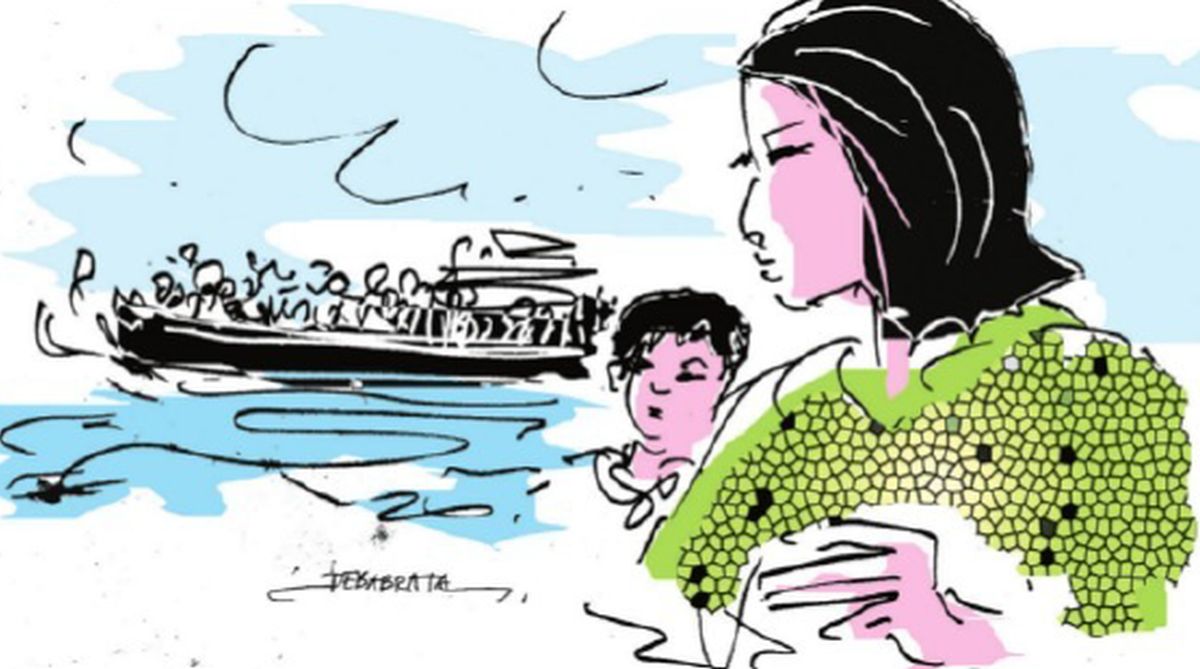Still unexplained
The hunt for the origins of Covid-19 has for the past four years been a tangled web of politics, power struggles, and international finger-pointing.

Illustration: Debabrata Chakraborti
From the Tan Son Nhat airport she took a taxi and, bypassing Ho Chi Minh city, went straight to the Vung Tàu port area. The area had changed, and it took her time and much walk before she found the spot she was looking for. Yes, this was place she caught a boat in the dead of night thirty years ago.
Linh was 24 then. But she had to take a decision that would have daunted someone double her age or experience. She had to decide whether to take the boat.
She was Vietnamese, but of ethnic Chinese origin, a Hoa. For centuries turbulent changes in regime in China had pushed thousands of migrants in Vietnam, and in early twentieth century the exodus rose with the civil war in China. The Hoa community was diligent and enterprising, and in time prospered in trade and business. Both North and South Vietnam declared interest in integrating the community in Vietnamese society but at an onerous price: they had to adopt Vietnamese names and abandon their culture.
Advertisement
North Vietnam’s relations with China deteriorated with the Vietnam War of 1967-68. The Hoas’ position became untenable after the reunification of Vietnam. The authorities banned private trading, closed thirty thousand businesses overnight, confiscated currencies, and forced owners to work as farmers or as soldiers. All resistance was met with violence. A mass exodus began.
Now, in the summer of 1979, Linh had nothing to keep her back in Vietnam. There was no future for her or her three-year-old son except dire poverty and social ostracism.
The only alternative was to flee the country illicitly, in an unsafe boat run by coyotes, and pay an extortionate price for a nightmare journey. Accidents and drownings were common; so were skirmishes and violence. Pirates robbed and raped migrants, regularly and mercilessly. And at the end waited an uncertain future: nobody knew which country would accept them, or even what shore they would be able to reach.
Linh gritted her teeth and made up her mind. She took every penny she had saved and sold everything she owned except the clothes on her back or on her son. With the money she bought a few small ingots of gold, the only payment the coyotes would accept. Then she negotiated the earliest possible day of escape: the following Saturday night, when the piers were quiet and the guards often drunk.
Linh knew night boarding was the safest in eluding the port police but, physically, the most dangerous. There were narrow planks one had to balance on to reach the cavern of the boat, and people had been known to fall and drown. With her delicate frame, Linh had to balance both her child and the small bag in which she carried an extra pair of clothes, some water and dry food. She teetered cautiously along the plank and reached the boat. It was already packed to the gills with fleeing men and women. No matter, the coyotes kept adding more passengers, until, in the corner she had found, her child had to crane his head to breathe.
The horrendous journey lasted three weeks, twenty-one days of heat, stench, parched lips and near starvation. Their boat was in Hong Kong. Half-dead with exhaustion, Lynh waited with her child, along with the others, for a word from the authorities. The good news was that they wouldn’t be sent out in the sea again; the bad news was that the refugee camps were full, and they would have to wait for days.
The refugee camp run by the Red Cross in Hong Kong was a quickly assembled affair, inadequate both in resources and compared to the need. It was crowded, congested, one might say brutally basic. But Lynh was finally safe. Her child, though in tatters, gamboled gaily with the other children also in tatters. Lynh started entertaining the dream that she will have a break and one day have a place of her own. She could then dress her child well and give him a good education. It wasn’t a unique dream among the skeletal men and women who had experienced the worst and survived.
Three months later, unlikely as it was, Lynh’s dream came true. A New York church group offered sanctuary and support for Lynh and her son. The Christmas of 1979 brought them the promise, not just of safety, but also of a different life.
The US shores awaited Lynh, doubtless with huge challenges, of learning a new language and adjusting to a different culture, but also with the assurance of security and freedom. She could choose her life. Her son could be the man he wanted.
Linh paused in her narration. Now 54, trim and petite, with a round face and radiant smile, Linh sat in a bistro with me, a glass of red wine in her hand. She said, “I don’t know how I found the gumption to risk that boat trip. I was desperate. I just wanted a new life for me and for my child.”
I looked at her and wondered about the hundreds of other desperate women and children, ready to risk all for the chance of a new life, and the obduracy of our prejudices that want to close the door and raise a wall.
The writer is a Washington-based international development advisor and had worked with the World Bank. He can be reached at mnandy@gmail.com
Advertisement